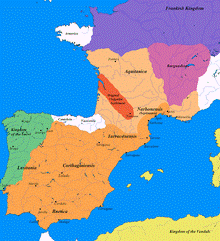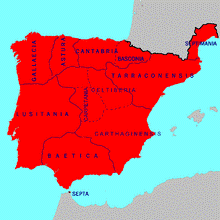
Migrations of the main column of the Visigoths
Visigoths
Earliest ancestors (44th Great Grandfather): Alaric II, King of the Visigoths (470 - 507 AD);
(43rd Great Grandfather): Amalaric II (son of Alaric II), King of the Visigoths (492 - 531 AD);
(43rd Great Grandmother): Clotilda (wife of Amalaric II), Princess of the Franks (507 - 531 AD)
The Visigoths (Latin: Visigothi, Tervingi, Wisigothi, Vesi, Visi, Wesi, or Wisi) were one of two main branches of the Goths, the Ostrogoths being the other. Together these tribes were among the Germanic peoples who spread through the late Roman Empire during the Migration Period. The Romanized Visigoths first emerged as a distinct people during the 4th century, initially in the Balkans, where they participated in several wars with Rome. A Visigothic army under Alaric I eventually moved into Italy and famously sacked Rome in 410.
Eventually the Visigoths were settled in southern Gaul as foederati of the Romans, the reasons for which is still a subject for debate among scholars. They soon fell out with their hosts and established their own kingdom with its capital at Toulouse. They slowly extended their authority into Hispania, displacing the Vandals and Alans. Their rule in Gaul was cut short at the Battle of Vouillé in 507 when they were defeated by the Franks under Clovis I. Thereafter the only territory north of the Pyrenees that the Visigoths held was Septimania, such that their kingdom became limited to Hispania. The province came to be dominated by the Visigothic small governing elite at the expense of the Byzantine province of Spania and the Suebic Kingdom of Galicia.
In or around 589, the Visigoths, under Reccared I, formerly Arian Christians, converted to the Nicene faith as the ethnic distinction (ancestry, language, religion, tribal dress, etc.) between the increasingly Romanized Visigoths and their Hispano-Roman subjects gradually disappeared. Liber Iudiciorum (completed in 654) abolished the old tradition of having different laws for Romans and for Visigoths, so that legal distinctions were no longer made between Romani and Gothi, coalescing them into Hispani.
The century that followed was dominated by the Councils of Toledo and the episcopacy. Historical sources for the 7th century are relatively sparse. In 711 or 712 the Visigoths, including their king and many of their leading men, were killed in the Battle of Guadalete by a force of invading Arabs and Berbers. The kingdom quickly collapsed in the aftermath, a phenomenon which has led to much debate among scholars concerning its causes. Gothic identity survived the fall of the kingdom, however, especially in the Kingdom of Asturias and the Marca Hispanica.
Of what remains of the Visigoths in Spain and Portugal there are several churches and an increasing number of archaeological finds, but most notably a large number of Spanish, Portuguese, and other Romance language given names and surnames. The Visigoths were the only people to found new cities in western Europe after the fall of the Roman Empire and before the rise of the Carolingians. Until the LateMiddle Ages, the greatest Visigothic legacy, which is no longer in use, was their law code, the Liber iudiciorum, which formed most notably the basis for court procedure in most of Christian Iberia for centuries after their kingdom's demise.
History

Migrations of the main column of the Visigoths
War with Rome (376–382)
The Goths remained in Dacia until 376, when one of their leaders, Fritigern, appealed to the Roman emperor Valens to be allowed to settle with his people on the south bank of the Danube, hoping to find refuge from the Huns. Valens permitted this, as he saw in them "a splendid recruiting ground for his army." However, a famine broke out and Rome was unwilling to supply them with the food they were promised nor the land; open revolt ensued leading to 6 years of plundering and destruction throughout the Balkans, the death of a Roman Emperor and the destruction of an entire Roman army.
The Battle of Adrianople in 378 was the decisive moment of the war. The Roman forces were slaughtered and the Emperor Valens was killed during the fighting. Adrianople shocked the Roman world and eventually forced the Romans to negotiate with and settle the barbarians within the empire's boundaries, a development with far reaching consequences for the eventual fall of Rome.
Reign of Alaric I
The new emperor, Theodosius I, made peace with the rebels, and this peace held essentially unbroken until Theodosius died in 395. In that year, the Visigoths' most famous king, Alaric I, took the throne, while Theodosius was succeeded by his incapable sons: Arcadius in the east and Honorius in the west.
Over the next 15 years, an uneasy peace was broken by occasional conflicts between Alaric and the powerful Germanic generals who commanded the Roman armies in the east and west, wielding the real power of the empire. Finally, after the western general Stilicho was executed by Honorius in 408 and the Roman legions massacred the families of 30,000 barbarian soldiers serving in the Roman army, Alaric declared war.
After two defeats in Northern Italy and a siege of Rome ended by a negotiated pay-off, Alaric was cheated by another Roman faction. He resolved to cut the city off by capturing its port. On August 24, 410, however, Alaric's troops entered Rome through the Salarian Gate, to plunder its riches in the sack of Rome. While Rome was no longer the official capital of the Western Roman Empire (it had been moved to Ravenna for strategic reasons), its fall severely shook the empire's foundations.
Visigothic kingdom

Greatest extent of the Visigothic kingdom of Toulouse
in orange dark and light, c. 500
The Visigothic Kingdom was a Western European power in the 5th to 7th centuries, created in Gaul when the Romans lost their control of their empire. In response to the invasion of Roman Hispania of 409 by the Vandals, Alans and Suevi, Honorius, the emperor in the West, enlisted the aid of the Visigoths to regain control of the territory. In 418, Honorius rewarded his Visigothic federates by giving them land in Gallia Aquitania on which to settle. The settlement formed the nucleus of the future Visigothic kingdom that would eventually expand across the Pyrenees and onto the Iberian peninsula.
The Visigoths' second great king, Euric, unified the various quarreling factions among the Visigoths and, in 475, forced the Roman government to grant them full independence. At his death, the Visigoths were the most powerful of the successor states to the Western Roman Empire.
The Visigoths also became the dominant power in the Iberian Peninsula, quickly crushing the Alans and forcing the Vandals into north Africa. By 500, the Visigothic Kingdom, centred at Toulouse, controlled Aquitania and Gallia Narbonensis and most of Hispania with the exception of the Suevic kingdom in the northwest and small areas controlled by the Basques and Cantabrians. However, in 507, the Franks under Clovis I defeated the Visigoths in the Vouillé and wrested control of Aquitaine. King Alaric II was killed in battle.
After Alaric's death, Visigothic nobles spirited his heir, the child-king Amalaric, first to Narbonne, which was the last Gothic outpost in Gaul, and further across the Pyrenees into Hispania. The center of Visigothic rule shifted first to Barcelona, then inland and south to Toledo. From 511 to 526, the Visigoths were ruled by Theodoric the Great of the Ostrogoths as de jure regent for the young Amalaric.
In 554, Granada and southernmost Hispania Baetica were lost to representatives of the Byzantine Empire (to form the province of Spania) who had been invited in to help settle a Visigothic dynastic struggle, but who stayed on, as a hoped-for spearhead to a "Reconquest" of the far west envisaged by emperor Justinian I.

Visigothic Hispania and its regional divisions in 700,
prior to the Muslim conquest.
The last Arian Visigothic king, Liuvigild, conquered the Suevic kingdom in 585 and most of the northern regions (Cantabria) in 574 and regained part of the southern areas lost to the Byzantines, which King Suintila reconquered completely in 624. The kingdom survived until 711, when King Roderic (Rodrigo) was killed while opposing an invasion from the south by the Umayyad Muslims in the Battle of Guadalete on July 19. This marked the beginning of the Muslim conquest of Hispania in which most of the peninsula came under Islamic rule by 718.
A Visigothic nobleman, Pelayo, is credited with beginning the Christian Reconquista of Iberia in 718, when he defeated the Umayyads in battle and established the Kingdom of Asturias in the northern part of the peninsula. Other Visigoths, refusing to adopt the Muslim faith or live under their rule, fled north to the kingdom of the Franks, and Visigoths played key roles in the empire of Charlemagne a few generations later.
During their long reign in Spain, the Visigoths were responsible for the only new cities founded in Western Europe between the 5th and 8th centuries: Reccopolis, Victoriacum, Luceo, and Olite. There is also a possible fifth city ascribed to them by a later Arabic source: Baiyara (perhaps modern Montoro). All of these cities were founded for military purposes and three of them in celebration of victory.